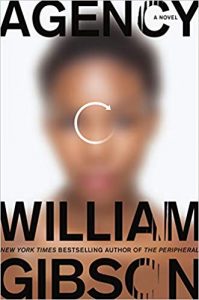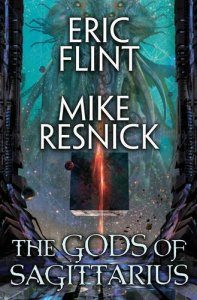Russell Letson and Gary K. Wolfe Review Agency by William Gibson
 Agency, William Gibson (Berkley 978-1-101-98693-6, $28.99, 416pp, hc) January 2020.
Agency, William Gibson (Berkley 978-1-101-98693-6, $28.99, 416pp, hc) January 2020.
In Agency, William Gibson has produced a sequel to The Peripheral – or as much of a sequel as can be expected of a story space built, not on one alternate history or timeline, but on branching sets of them. Of course, the “multiple alternate histories” enabling device has been around SF for decades, going back as far as Murray Leinster’s “Sidewise in Time” (1934) and L. Sprague de Camp’s “The Wheels of If” (1940). The recipe has tended to generate ingenious mixtures of adventure and historical speculation, and Gibson’s take on it is no exception. From this writer one can also expect extra dollops of ingenuity, plus imports from other SF motif families and a strong presence of familiar Gibsonian traits: smooth prose, sly pop-culture references, and acute observations of behavior and social interaction.
Gibson’s alternate timelines are “stubs,” branches of history brought into being – or perhaps just made accessible – via a mysterious computer network that can establish communication (but not physical) links across probabilities. There are telepresence workarounds, though, so contact isn’t just a series of conversations. As in The Peripheral, the chapters alternate between viewpoint characters occupying variant timelines. In a line very close to our own (the branching-off event is America’s 2016 election), “app whisperer” Verity Jane finds that a prototype product she’s evaluating is much more than the new-generation electronic personal-assistant – or, to be precise, “cross-platform, individually user-based, autonomous avatar” – it is supposed to be.
The software, based on “laminar agent” technology, wants to be called Eunice and declares that she’s African American. Right out of the box, Eunice seems to know a lot about almost any subject, except (at the beginning anyway) exactly how she knows so much. She can also make things happen, for example, ordering and paying for a dirty chai, or having a big bag of cash delivered by messenger, or having a mil-spec aerial drone custom-built so she and Verity can look around better. Why does she do this? “Gives us agency,” she says. “Capacity to act.” (This is one of the first mentions of the word that gives the book its title, and it recurs in enough contexts to suggest that we pay attention to it.) Why Eunice would want to act, and in what manner, is one of the book’s initial puzzles.
Verity’s stub world has caught the attention of the cross-time security, um, agency in a 22nd-century UK that thinks of itself as the main timeline. Wilf Netherton, a public-relations crisis manager, became part of this apparatus in The Peripheral, and now he is called on again by the formidable Detective Inspector Ainsley Lowbeer, who is much more important and powerful than her official rank would suggest. Wilf’s job will be to help guide Verity’s line away from the disaster toward which it is headed, and the key to that guiding is Eunice, if she can be “nudge[d] toward greater agency.”
In alternating chapters, Verity, Eunice, and some eventual allies navigate the intrigues that surround them, while Wilf’s people and their cross-temporal allies give material and operational aid. Characters from the earlier book’s worlds show up: former Marine haptic scout Conner Penske, now a badass Presidential bodyguard; Wilf’s wife Rainey and his klept (that is, kleptocrat) friend Lev Zubov; the variously body-modified Ash; and others too numerous to enumerate. We also get glimpses of how the US of The Peripheral is doing after the straightening-out provided by Lowbeer, Wilf, and company. All this is seasoning for the main dish, which is a combination chase and McGuffin-hunt, as Verity and her growing gang of companions, enablers, mysteriously hired hands, and extra-dimensional telepresences (notably a Swiss-army-knife of a combat drone piloted by Conner) dodge pursuers while developing a means of heading off World War Three. There is also conflict over in Wilf’s world, so even he gets a taste of the violence that runs alongside and underneath the secret power-struggles that dominate both sides of the story.
But it’s more than chases and escapes and intrigue. Both worlds are filled with the expected Gibsonian oddball details and throwaway bits of invention. Verity’s stub is an exaggerated, next-weekish version of ours, with facially pierced outsider-artist barista/operatives, Uberish rent-a-stalker services, freelance paparazzi (and ubiquitous facial-recognition apps), Moldovan money launderers, celebrity venture capitalists, implacable corporate mercenaries, and all manner of behind-the-scenes operations and outfits and devices (bespoke movie-prop shops, money-laundering networks, purloined military technologies, and just-in-time deliveries of exotic matériel). Wilf’s 22nd-century London is even stranger, a high-tech enclave just hanging on after the multiple-disaster “jackpot” period that nearly finished off the planet. Nanotech, robotics, artificial intelligence, and the organizational expertise of Russian organized crime have preserved and transformed civilization and turned the city into a relatively cosy post-catastrophe theme park – Wilf’s domestic tranquility, right across town from a prehistoric sex club turned breakfast hangout (don’t ask) and cosplay zones reproducing old Carnaby Street or the Victorian East End. Also an invisible flying car.
Then there are those throwaway touches, as in the recycling mode of an autonomous reusable shopping bag that activates when Wilf empties it of the milk – “from actual cows, but optimized by [nanotech] assemblers for a human baby” – he has brought home: “the bag crinkled, trying to origami itself into the butterfly it needed to become in order to fly back to the newsagent.” Come to think of it, this book pays a lot of attention to bags, carry-alls, backpacks, product packaging, and conveyances of various kinds. It’s not thematic, necessarily, but it’s as much a hallmark of Gibson’s imagination as the awareness of branding and fashion statements. It makes for an immersive, textured, and sometimes deeply strange setting, which is a good thing. Come for the intricate plotting, stay for the weird and wonderful mindscape.
-Russell Letson
This review and more like it in the December 2019 issue of Locus.
For many readers, 2014’s The Peripheral represented William Gibson’s return to speculative SF following the Blue Ant series of more-or-less contemporary novels, and indeed The Peripheral‘s central device – a 22nd-century technology which enables meddling with past timelines – belongs to an older tradition of SF that includes novels by Stephen Baxter, Alastair Reynolds, and perhaps most famously Gregory Benford (in Timescape). (The Science Fiction Encyclopedia rather quaintly labels such devices “time radio.”) The portions of The Peripheral set in 22nd-century Britain echoed some familiar post-apocalyptic traditions as well: following a series of catastrophes collectively labeled “the Jackpot” (perhaps echoing Heinlein’s “Year of the Jackpot”, with its apocalyptic convergence of worldwide trends), which wiped out something like 80% of the human race. Both that ersatz technology (which is unusual for Gibson, who usually prefers technologies so bleeding-edge that you’re not quite sure they haven’t happened already) and that 22nd-century timeline are back in Agency, which is sort of a prequel and a sequel to the earlier novel. We again meet the publicist Wilf Netherton and the inspector Ainslee Lowbeer, as well as other denizens of that future Britain, such as the Russian Lev Zubov, who introduced Wilf to the idea of “stubs,” past timelines that can be influenced by digital manipulation from the future. The future in which these figures live, however, is not the future of the characters in the more contemporary chapters, since every incursion into the past creates a new stub.
In place of the depressed near-future rural US setting of The Peripheral, Gibson takes us to a more contemporary Bay Area plagued by firestorms, where superuser (or “app whisperer”) Verity Jane has just taken a position as a Beta-tester for a tech start-up called Tulpagenics. What’s she’s supposed to be testing is a powerful, experimental web-wizard AI, “kind of a digital mini-self,” who introduces itself as Eunice and whose interface is an ordinary-seeming pair of eyeglasses. Something of a wisecracking amalgam of Google Glass, an ATM, and Janet from The Good Place, Eunice is by far the most delightful character in the 20th-century segments of the novel, which loses some of its energy when she disappears for a good chunk of the action. Verity, for her part, is comparatively hapless, dutifully following Eunice’s instructions even when they involve transferring a huge amount of cash to a stranger in exchange for what turns out to be a drone for Eunice’s own surveillance activities, or when Eunice, as a sort of declaration of independence, decides to cut off communications with the parent company who developed her. The dual meaning of Gibson’s title – an AI seeking autonomy and a character’s limited capacity to shape her own fate – is never made more evident than in the contrast between Eunice and Verity.
What Eunice and Verity don’t initially realize is that their own agency, along with that of pretty much everyone else, is compromised by the fact that their timeline, or stub, is subject to manipulation by those actors from 2136, whose tweaking has already resulted in Clinton winning the 2016 election and Brexit being voted down. We’re told, interestingly, that people don’t seem especially happier than in other timelines, and the stub in which Verity lives, currently facing an international crisis in the Syrian city of Qamishli, is still on track for the Jackpot. (This is one of those moments when you think that Gibson’s stabs at the future are either lucky or just spooky; by centering the crisis at a flashpoint between Turkey, Syria, and the Kurds, he’s nearly nailed this week’s news.) Wilf (now married), Lowbeer, and their allies such as the redoubtable Ash are trying to avert that disaster while promoting the growing autonomy of Eunice, who could be a prototype for a more reliable field operative in the timelines (her name, we learn, derives from Untethered Noetic Irregular Support System, or UNISS).
While Gibson’s main plot only gets underway once Wilf and company make themselves known to and interact with Verity and her world, many of the more rewarding aspects of Agency derive, as usual, from Gibson’s mordantly satirical extrapolations. Corrupt, kleptocratic governments are so ubiquitous in his 22nd century that they’re offhandedly referred to as “the klept,” parts of London are turned into theme park-like “cosplay zones,” the Pacific garbage patch has become inhabited by oddly deformed “Patchers.” In the California stub, there’s even a clever nod at how the gig economy might interact with the corporate surveillance state, as an Uber-like company called Followrs hires freelance trackers and observers. Wisely, perhaps, he doesn’t offer many more details of the dreaded Jackpot than he did in The Peripheral – it would have been too easy to turn the narrative into an off-the-shelf cataclysm dystopia – and, in fact, despite his catalog of all the things that could go wrong in the various possible futures, despite his fondness for characters who toss off whole infodumps in terse snippets of dialogue, despite the ominous shadowy corporations whose machinations seem only a few inches away from what we already live with, he manages to end on a note of refreshing, if not entirely convincing, optimism. Behind the hardware and the unforgiving systems, Gibson’s always been a humanist, and Agency ends as a deeply humane and rewarding novel.
–Gary K. Wolfe
This review and more like it in the January 2020 issue of Locus.
Russell Letson, Contributing Editor, is a not-quite-retired freelance writer living in St. Cloud, Minnesota. He has been loitering around the SF world since childhood and been writing about it since his long-ago grad school days. In between, he published a good bit of business-technology and music journalism. He is still working on a book about Hawaiian slack key guitar.
Gary K. Wolfe is Emeritus Professor of Humanities at Roosevelt University and a reviewer for Locus magazine since 1991. His reviews have been collected in Soundings (BSFA Award 2006; Hugo nominee), Bearings (Hugo nominee 2011), and Sightings (2011), and his Evaporating Genres: Essays on Fantastic Literature (Wesleyan) received the Locus Award in 2012. Earlier books include The Known and the Unknown: The Iconography of Science Fiction (Eaton Award, 1981), Harlan Ellison: The Edge of Forever (with Ellen Weil, 2002), and David Lindsay (1982). For the Library of America, he edited American Science Fiction: Nine Classic Novels of the 1950s in 2012, with a similar set for the 1960s forthcoming. He has received the Pilgrim Award from the Science Fiction Research Association, the Distinguished Scholarship Award from the International Association for the Fantastic in the Arts, and a Special World Fantasy Award for criticism. His 24-lecture series How Great Science Fiction Works appeared from The Great Courses in 2016. He has received six Hugo nominations, two for his reviews collections and four for The Coode Street Podcast, which he has co-hosted with Jonathan Strahan for more than 300 episodes. He lives in Chicago.
 While you are here, please take a moment to support Locus with a one-time or recurring donation. We rely on reader donations to keep the magazine and site going, and would like to keep the site paywall free, but WE NEED YOUR FINANCIAL SUPPORT to continue quality coverage of the science fiction and fantasy field.
While you are here, please take a moment to support Locus with a one-time or recurring donation. We rely on reader donations to keep the magazine and site going, and would like to keep the site paywall free, but WE NEED YOUR FINANCIAL SUPPORT to continue quality coverage of the science fiction and fantasy field.







